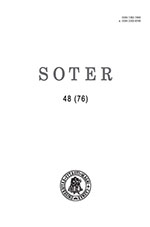Švč. Mergelės Marijos Ėmimo į dangų ikonografija XVII–XVIII a. Lietuvos dailėje
The iconography of the assumption of the blessed virgin mary In lithuanian art of the 17th–18th centuries
Author(s): Aušra VasiliauskienėSubject(s): Christian Theology and Religion
Published by: Vytauto Didžiojo Universitetas
Keywords: Iconography; Blessed Virgin Mary; Assumption; XVII c.; XVIII c.; religious art of Lithuania; prototype; copy
Summary/Abstract: Straipsnyje ikonografiniu metodu analizuojamos Švč. Mergelės Marijos Ėmimo į dangų vaizdavimo ypatybės XVII–XVIII a. Lietuvos dailėje. Aptariama siužeto kilmė ir raida Vakarų Europoje, atskleidžiamas teologinis matmuo. Nustatomos pagrindinės Lietuvoje plitusios ikonografinės-kompozicinės schemos, elementai, jų simbolika. Lietuvos atvaizdai lyginami su to paties laikotarpio Europos kūryba, pagal galimybes išaiškinami kūrinių pirmavaizdžiai. Straipsnis parengtas pagal Lietuvos mokslo tarybos finansuotą projektą „Krikščioniškoji ikonografija XVII–XX a. Lietuvos dailėje: tradicijos ir transformacijos“ (sutarties Nr. VAT-33/2012). The aim of the paper is to analyze the iconography of the Assumption of the Blessed Virgin Mary in Lithua-nian art of the 17th-18th centuries. The article discusses the origins and development of the storyline in Western Europe, reveals the theological dimension. It analyzes the iconographic peculiarities, compositional schemes, elements, their symbolic meaning in comparison with European creation of the same period. Ac-cording to the possibilities the pieces of art prototypes are ascertained. Assumption of the Mother of God in Lithuanian art of the 17th-18th centuries predominated in both easel and murai painting. This climactic moment was usually composed in church vaulting and cupolas which dur-ing the Baroque period were used for the depiction of apotheotic holy scenes. Remaining paintings witness that in the 17th-18th century iconographic compositions of ternary char-acter were spreading: the action can take place in heavenly or heavenly and earthly spheres; in the latter the apostles are grouped. Typical 17th century schemes have been created following Titian and Rubens proto¬types. This group is represented by Kaunas Archdiocese, Merkinė Church specimens. In the 18th century and especially in its 2nd half more rational, one sphere compositions become more frequent, their origin can be related with specimens created by Guido Reni, Bartolomé Esteban Murillo, Nicolas Poussin. Such group is illustrated in Prienai, Medingėnai, Raguvėlė churches and other paintings. In Lithuania copies of G. Reni s version of the Assumption are often found. The images in which the Assumption is combined with Immaculata iconographic type, for example in Kražiai, Rudamina paintings, make an interesting group. In spite of abundant mentioning of the subject of the Assumption of the Blessed Virgin Mary, the number of the 17th-18th century images that remain in Lithuania is not as numerous as it can be expected. The possible prerequisite can be the fact that in the 19th century these paintings were replaced by new ones.
Journal: SOTER: religijos mokslo žurnalas
- Issue Year: 76/2013
- Issue No: 48
- Page Range: 91-114
- Page Count: 24
- Language: Lithuanian

